Supermarine Spiteful F.Mk.14
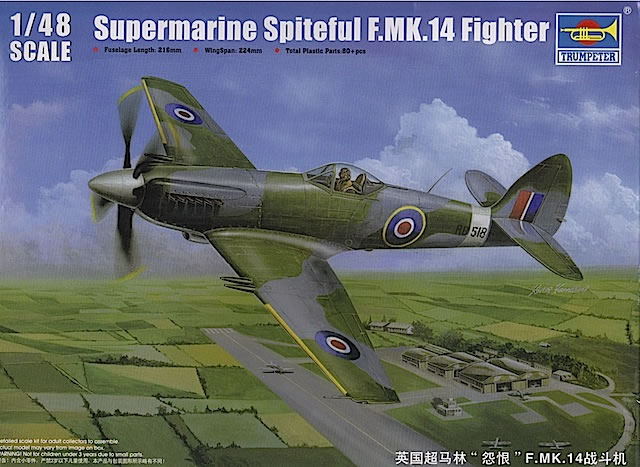
Trumpeter, 1/48 scale
| S u m m a r y : |
Catalogue Number: |
Trumpeter kit no.02850 – Supermarine Spiteful F.Mk.14 |
Scale |
1/48 |
Contents and Media |
80 mid-grey plastic parts; seven clear plastic parts; one decal sheet containing markings for one real and two fictional aircraft; one fret of photo-etched detail parts. |
Price |
Retail price around AUD$29.99. Distributed in Australia by J.B. Wholesalers. |
Review Type |
First Look |
Advantages |
Welcome subject; crisp mouldings |
Disadvantages |
Many inaccuracies and poor decals |
Conclusion |
It will take a lot of work to produce an accurate Spiteful from this kit. |
Reviewed by Brad Fallen

Trumpeter's 1/48 scale Supermarine Spiteful is available online from
Squadron
A chapter in one of Alfred Price’s Spitfire books, called "Test Flying the Spiteful", tells the experiences of Patrick Shea-Simonds as Supermarine's Deputy Chief Test Pilot between 1944 and 1946. Shea’s predecessor had died in the first Spiteful prototype, and only skillful flying saved Shea from the same fate in late 1945 when the supercharger of his Spiteful F Mk 14 disintegrated at 30,000 feet.
Shea eventually logged 82 hours in Spitefuls, and later recalled “as I got used to …[it] I found it not unpleasant to fly. It took off all right and its high speed performance was quite good. To be frank I never liked the “feel” of it as much as I liked the “feel” of the Spitfire, but…they were such beautiful aircraft to fly that it would have been difficult to find anything else that felt as nice”.
Therein lies one of the reasons why the Supermarine Spiteful has had such a bad press. Taken in isolation, the Spiteful was an extremely advanced piston-engined fighter that would probably have seen RAF service had the war lasted beyond 1945. But as a development of the Spitfire, it didn’t meet expectations. Two years of intense work by Supermarine, including the design of a new, laminar flow wing, resulted in an aircraft that offered little advantage over the Griffon Spitfires then in service. And while the Spiteful was very fast – in 1947 one reached 494 mph in level flight – it wasn’t fast enough to compete with the new jets. This obsolescence, along with post-war budget cutbacks, saw the British Air Ministry gradually reduce its original order of 650 Spitefuls to less than 20. None survive today.
The Spiteful has fared better in model form than it did in real life. There have been at least four 1/72 kits, by Rareplanes (vacform), CMR (resin) and Pegasus and AZ Model (both limited run injected plastic). In 1/48, there are kits from Falcon (vacform and white metal), Heritage Aviation (resin) and Silver Cloud (injected plastic and white metal).
None of these kits are for beginners. The Silver Cloud kit has attracted savage criticism for its engineering and accuracy, and the Falcon kit – while far more highly regarded – is still a challenging build. I bought a Falcon Spiteful shortly after getting back into modeling in 2004 but put it aside after I had removed the main plastic parts from their backing sheet, realising that my ambition had exceeded my abilities by a considerable margin. While in my mind I have never completely abandoned the Falcon project, I was still delighted when Trumpeter released an injected moulded 1/48 Spiteful earlier this year.
This latest Spiteful kit, however, also has come in for criticism. Online reviews and build logs have identified a number of problems with the kit, while also offering some innovative solutions.* Trumpeter’s Spiteful is clearly a mixed bag, and so it was with some trepidation that I lifted the lid on the review sample.
As with most current Trumpeter kits, the Spiteful looks good in the box. The plastic parts are crisply moulded, with fine panel lines and no sink marks or flash. While there are more rivets than I would like to see, they are very finely reproduced. A test assembly of the major parts revealed sensible engineering and good fit. The instructions are clearly set out, a small photo-etched fret provides some extra detail for the underwing radiators, and the kit’s modest parts count means construction out of the box should be straightforward and relatively fast.
Unfortunately, building the kit as-is will also result in a model that has some significant inaccuracies. I have reached my conclusions by examining the parts on the sprues and dry fitting the major components, and then comparing both against period photographs (the Price book has some excellent images), 1/48 scale plans from the Falcon kit, and the main Falcon airframe parts, which I understand are dimensionally accurate.
I have taken a number of side-by-side photographs of the Falcon and Trumpeter parts, which should help to illustrate my points about the Trumpeter kit. However, ignore the vertical fin and rudder of my Falcon Spiteful – I decided at one stage that I was going to finish it as NN664, the second F Mk 14 prototype, and so grafted a spare Academy Spitfire Mk XIVe tail unit on to the Falcon fuselage. (The fit was surprisingly good!) The Trumpeter kit is moulded in grey, while the Falcon kit is white.
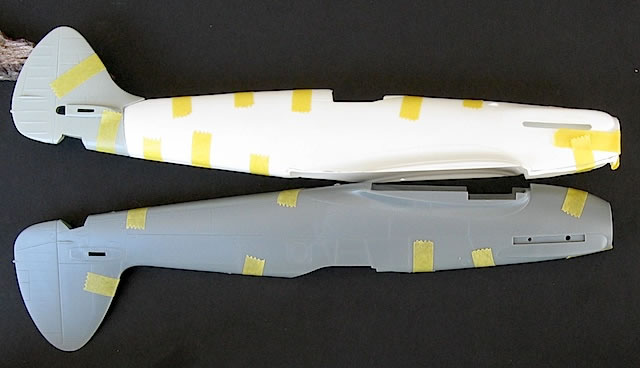
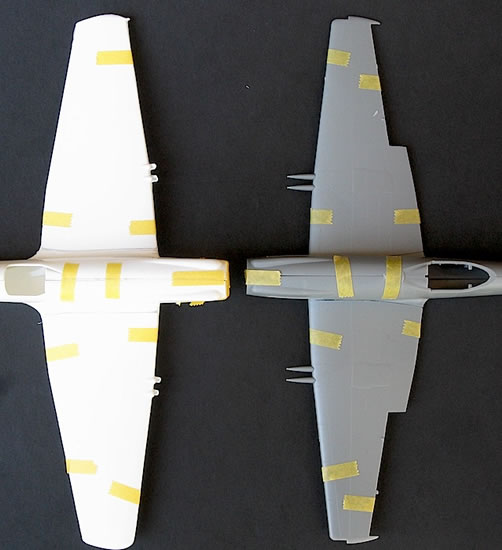
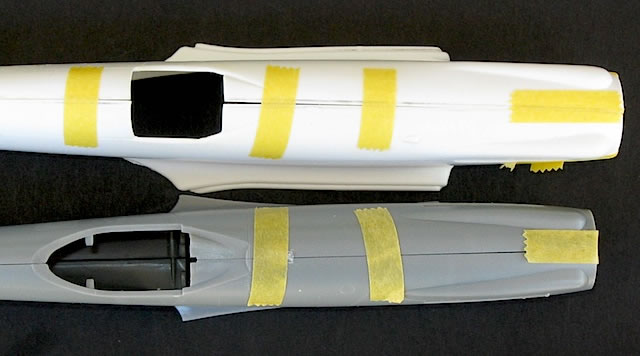

My thoughts on the accuracy of Trumpeter’s Spiteful are as follows. Please note that these points are not intended to be exhaustive – they are just the main issues that struck me when I was looking at the kit.
-
Location of wings to fuselage. This is the kit’s major flaw. I don’t know how Trumpeter did it, but they made the wing-to-fuselage join too far forward. The problem is not particularly apparent when the parts are on the sprues, but is obvious when the wings and fuselage are test fitted. I’ve seen photos of several Trumpeter Spitefuls that have been finished without addressing this problem, and to me at least, they just look wrong. Have a look at the comparative photos of the Trumpeter and Falcon airframes, and you will see what I mean.
-
Wing fillet. Trumpeter has not accurately reproduced the Spiteful wing fillets. On the real thing, and also on the Falcon kit, the fillets curve back in a graceful arc from the wing trailing edges to almost behind the cockpit. Trumpeter’s fillets are too pinched in along the side of the wings, and also taper away too quickly after they leave the trailing edge.
-
Fuselage and vertical stabiliser. Assuming that the 1/48 plans that come with the Falcon kit are accurate, then Trumpeter’s fuselage is close to spot-on in terms of dimensions. There is a possibility that the lower fuselage beneath the cockpit is slightly undernourished, and the leading and trailing edges of the vertical fin may also be slightly too straight (the trailing edge issue could be fixed by removing the kit rudder and replacing it with one intended for an Airfix Spitfire Mk 22/24 kit). Please note that the Falcon plans are for a Seafang, so the long carburetor intake beneath the engine is not applicable to the Trumpeter Spiteful.
-
Unfortunately, there are some problems with the fuselage. While I haven’t done an exhaustive comparison, the location of some of the panel lines and hatches appears to be dubious, at best. Like many manufacturers, Trumpeter has not quite captured the bulges on the engine cowling that were required to accommodate the Griffon engine. And the unnecessary fuselage cut-out behind the cockpit will take some work to fix.
-
Wing dimensions. When overlaid on the Falcon plans, Trumpeter’s wings appear to be slightly too narrow from front to back. The blisters behind the shell ejector ports on the lower wings are the wrong shape and size, and Trumpeter’s depiction of the upper wing cannon access hatches as raised panels looks slightly peculiar. Otherwise the wings appear OK, although I haven’t done a detailed panel-by-panel comparison with reference photos or the Falcon kit wings.
-
Cockpit. Trumpeter’s cockpit is an improvement over those offered by Silver Cloud (a Spitfire cockpit) and Falcon (build it yourself), but it’s still a little half-hearted. Photos of Spiteful cockpits aren’t plentiful, but they are out there, and Trumpeter could have delivered something better than the Spiteful-ish effort that is presented here.
-
Canopy. Trumpeter provides this in two parts, which both appear to be the correct shape and size (although there were some variations in the shape of the windscreen, so check your references). Unfortunately they are also quite thick, and the sliding section has a seam down the centre that will have to be removed – probably an unavoidable limitation of the moulding process. So while the kit canopy is useable, I’m probably going to replace it with a spare from my Falcon kit.
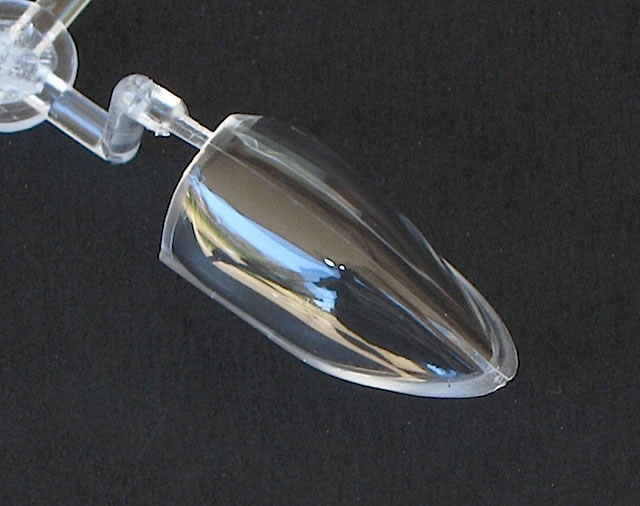
-
Propeller blades and spinner. Trumpeter has thoughtfully moulded the distinctive five-bladed propeller as a single piece, eliminating any potential alignment problems. The shape of the prop blades appears reasonable, although perhaps a little pinched in at the tip of the leading edge. Next to reference photos, the spinner looks slightly elongated, but not fatally so.
-
Wheel wells. Trumpeter provides fully enclosed wheel well inserts that slot into place above the lower wing. These are nicely detailed (although I can’t vouch for their accuracy, having no reference pictures of the real thing) but also unfortunately much too shallow.
-
Main gear struts. The kit’s main gear legs are inaccurate, being too short and the wrong shape. This is in comparison with Falcon’s white metal parts, which appear to be correct.
-
Wheels. Trumpeter’s main wheels have three-spoke hubs, which matches my reference photos and the Falcon wheels. However, the SAM Datafile on Griffon Spitfires indicates that some Spitefuls also had four-spoke hubs, so I’d recommend checking your references carefully before fitting wheels to your model. In any case the Trumpeter wheels are going to need replacing, because they are too small – check the comparison photo with the Falcon wheel, which is a more accurate size.
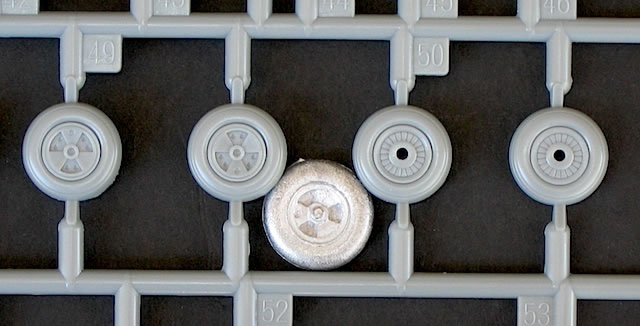
Marking Options and Decals
Trumpeter provides marking options for one real and two fictional aircraft. The latter are for a natural metal or silver lacquer Finnish Spiteful, and a Dutch aircraft camouflaged in an approximation of the RAF’s late war day fighter scheme. Unfortunately, when it comes to the real option, Trumpeter has been let down by its research. While the kit is marketed as a ‘Spiteful F Mk 14’, decals are provided for the only F Mk 16 to be constructed (RB518), a point not indicated anywhere on the marking guide. RB518 underwent a number of changes in its lifetime, including the fitting of different carburetor intakes and windscreens. I have a good reference photo of RB518 in the form represented by the Trumpeter kit, so the decals are not inappropriate – but this is another mistake that adds to the impression of sloppiness around the kit’s production.
The decals themselves are of poor quality: the colours in the Finnish and RAF roundels are out of register, and the red of the RAF markings is too bright. However, the ‘RB518’ serials have been accurately reproduced, down to the tiny stencil overlay lines on the ‘5’ and the ‘8’.
This kit has problems that cannot be ignored.
The Spiteful is an attractive and historically significant aircraft that has, until now, been patchily represented in 1/48 kit form. Unfortunately, the errors in Trumpeter’s kit means that the 1980s-era Falcon vacform is still the most accurate 1/48 Spiteful on the market. But while the Falcon kit is readily available, I can vouch that it is only really suitable for experienced modelers. The Trumpeter kit can be improved: I have seen one on-line build where the modeler cut out the entire lower fuselage and wing root area and moved it back by several millimetres, thus addressing the kit’s most obvious inaccuracy. However, fixing the wing location is only part of the battle, and it will take a lot of work to produce an accurate Spiteful from this kit. I don’t know if Trumpeter are intending to modify this kit for future release as a Seafang, but if they are, I hope they address some of its inaccuracies while doing so.
*Rowan Bayliss has recently posted a very comprehensive, nose-to-tail analysis of the Trumpeter Spiteful over on Aeroscale.
References
-
Robert Humphreys, The Supermarine Spitfire – A Comprehensive Guide for the Modeller, Part 2: Griffon-Powered (SAM Publications, 2001)
-
Alfred Price, Spitfire: A Complete Fighting History (Promotional Reprint Company, 1991)
-
Falcon Industries, 1/48 Supermarine Seafang/Spiteful, kit and instructions

Text and Images Copyright © 2012 by Brad Fallen
Page Created 17 September, 2012
Last updated
17 September, 2012
Back to HyperScale Main Page
|
